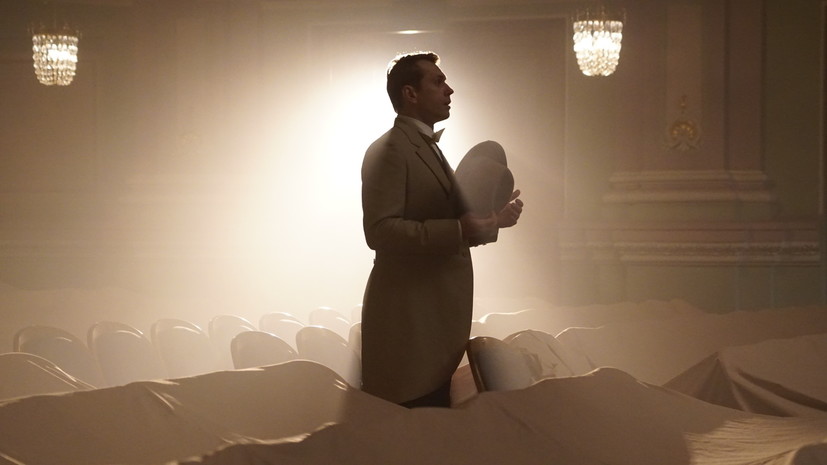On Monday, February 13, on the occasion of the 150th anniversary of the birth of Fyodor Chaliapin, a series about the legendary opera singer will be released on the Rossiya TV channel and the Okko video service.
The artistic picture covers a solid part of the artist's life - from childhood spent in Kazan to maturity, when the name of Chaliapin thundered throughout the country and beyond.
The first episodes of the series are dedicated to the early years of the life of the future singer.
The father, played by Fyodor Dobronravov, is trying to involve the boy in some business - he sends him to study with a shoemaker, then he arranges messengers, but all to no avail.
The boy is keenly interested in the theater, even gets into the choir at the production of "Mephistopheles", because of which he later gets into a lot of trouble, but he is clearly aware of his destiny.
Thus begins the path of a great artist.
Much attention is paid to the life and work of Chaliapin in Moscow and St. Petersburg - here he is already an accomplished star: his mansion is besieged by fans, photographs are sold like hot cakes, and the character of the hero leaves much to be desired.
Hot-tempered, sharp, at times rude, but incredibly talented artist, whose image was embodied by Alexander Gorbatov ("Quiet Don", "Young Guard", "Wings of the Empire"), looks like a rock star of the Silver Age.
It surprisingly combines peasant stinginess (the hero leaves the carriage, considering that five rubles is too high a price for a trip, but three is just right) and generosity (more than three dozen artists live on Chaliapin’s money, whose star has already set) .
He deeply experiences the events of Bloody Sunday, performing "La Marseillaise" on the stage of the Bolshoi Theater, which causes dissatisfaction with officials,
Chaliapin in the film looks incredibly convincing and alive - this is manifested in his every noble impulse, barbs, narcissism, generous deeds and tyranny.
He cannot be called an unambiguously positive or negative hero, he is an artist who lives by his work, but he is also a star with a full range of “hops”.
So, for example, after a nightmare before the premiere of "The Demon" at the Bolshoi Theater, the hero declares that he will not participate in the production, citing a sore throat - in a dream his voice let him down, and the audience booed the singer and threw tomatoes at him.
Under pressure from his wife, the Italian ballerina Iola Tornaga (Maria Smolnikova), the secretary and attending physician, Fedor agrees to sing, arrives at the theater and immediately provokes a conflict with the conductor, condescendingly explaining that “he has already rehearsed everything with the orchestra and made notes in the right places ".
The resounding success of the performance ends with a scene where Chaliapin is carried out of the theater in his arms.
© Shot from the series "Chaliapin"/kinopoisk.ru
A somewhat painful impression is formed from the relationship between Chaliapin and his wife.
Iola is a former ballerina from Milan (it’s worth making a nod to Smolnikova, her Italian accent and manners in the film are simply impeccable), who quit her career for the sake of her beloved man, became his wife and mother of many children.
The heroine struggles to find a common language with her husband, whose difficult character is exacerbated by "star disease", and love affairs (unreasonably at first) are savored by the tabloid press.
Conflicts become an integral part of married life, Chaliapin spends less and less time at home, and after some time falls in love with his own fan - Maria Petzold (Yulia Snigir) and begins to live in two families in two cities.
Chaliapin's "live" performances in the tape are a separate occasion for delight.
The scenography, costumes, make-up, the work of Alexander Gorbatov are amazing.
In addition, the image of Chaliapin could not be completed without a great voice.
And this voice was found - all the arias of the legendary bass in the film were performed by one of the best domestic opera singers of our time, Ildar Abdrazakov.
Moreover, the work was complex: first, they recorded the parts for which Gorbatov worked on the set, and subsequently Abdrazakov re-recorded all the necessary fragments, based on Gorbatov's video recordings and placing the necessary accents, depending on the facial expressions and articulation of the actor.
The titanic work of the artists of the painting deserves special mention - Moscow and St. Petersburg look as authentic as possible to the declared era, there is no feeling of falsehood and irregularity, the interiors and exteriors are made at the highest level.
In total, more than 130 film sets are involved in the film - in both capitals, Nizhny Novgorod, Kostroma and other cities.
Filming also took place at the Bolshoi, Alexandrinsky, Mariinsky theaters, the house-museum and the Chaliapin estate museum.
Costumes and makeup are also on top, although not without reservations.
Still, the outfits of the workers in the circus scene look too clean and neat, and some of the hairstyles turned out to be too modern, but against the backdrop of all the grandiose work done, these shortcomings are just a trifle.
"Chaliapin" is an ambitious project, the plot of which balances on the verge between a documentary and a work of art.
It tells the story of one of the most famous opera singers and a country on the verge of global change in an incredibly interesting way.

